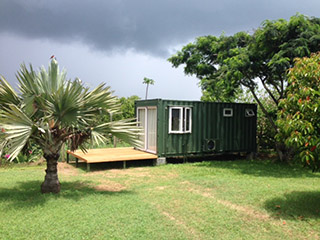Feeling cramped in your vessel's sleeping quarters? How about living in a shipping container?
Repurposed containers have become the hot trend in housing, ranging from basic, affordable one-room guest "cottages" to sophisticated designer homes created by top-flight architects.
Repurposed sea containers have been around for a long time, often used as a cheap housing alternative in poor countries or as temporary housing for asylum seekers or those displaced by hurricanes or earthquakes. Today, they are used much more widely - as schools, offices, artist studios, bank vaults, pop-up retail stores, medical clinics, recording studios, concession stands, and even Starbucks cafes. A container city has been built in London, and in Amsterdam, they have stacked them to make 1,000 student dorm units.
The pros: built to sustain harsh ocean travel, containers are strong, readily available and durable. They are cheap to buy (about $2,000) and quick to install - often up and running in just a few days time. And they can be easily moved to another location, or added to if you want to stay put.A container house in Mauritius. Pamela Glass photo.
Cons: Tight space (containers are typically 20’ or 40’ long, 8’ wide, and 8’ high), and the need to totally clean the structure inside and out before it is fit for habitation. The floors must be removed, and the walls sandblasted to remove toxic paints or other hazardous materials that may have leaked during its life at sea. It then must be repainted with non-toxic paints and insulated properly.
I am currently on the island of Mauritius in the Indian Ocean, where containers are all the rage. There are the rusty variety that are used as construction sheds. The local sports center has one that's been cut out as a refreshment stand near the soccer field. A home deco store has one in the parking lot to stock furniture, and more and more of them are being used as primary or secondary homes.
All of these are repurposed shipping containers, retired after a life of slogging around the world on decks of international container ships. Instead of melting them down or parking them in abandoned lots, they are being cleaned out, refitted and reimagined by shipping companies seeking a new eco-business opportunity or by forward-thinking entrepreneurs with some neat ideas.
My husband's cousins have just installed a 20-foot long container in the backyard of their son's home on the island and they use it as their base when visiting from France. Last week I had the chance to see their new "home," and thought it was pretty cool. From the outside, it does look like a container, save for the added deck, the sliding glass doors, and the cut-out windows. It was painted dark green, blending in well with the tropical garden around it. Step inside, and there are no signs that this steel box once was at sea - no dents, no rust, no foul smells, just a cute kitchenette with running water and electricity, a bedroom and a bathroom with shower, all built to the design of the owners, Jacques and Sybille de Navacelle. Total cost? About $16,500.
"I was surprised to see that we can be comfortable in such a small place," said Jacques, who is accustomed to much more spacious, atmospheric and complicated living in his family's chateau in Normandy. "It looks like a boat where we optimize as much as we can the space available. We were able to build a cupboard to store quite a lot of things. I found it also very pleasant to be living and feel being totally immersed in nature."
Many shipping companies sell their unused containers, and there's a crop of new companies in the U.S. and abroad that specialize in custom-made, factory-built containers for housing that will be delivered in "turn-key" condition.
There are hundreds of thousands of discarded containers around the world, a reminder of the dark side of global consumerism. This is especially a problem in the United States, where the import of goods far exceeds exports. Empty containers are too expensive to ship back to their homeport, so they are often scrapped or just left abandoned at their destination. Converting them to other uses could be an alternative way forward.




